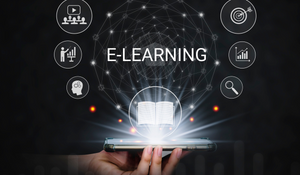 The COVID-19 pandemic disrupted our nationwide educational system. Closures rattled public confidence in local schools. Familiar routines were shattered. Interest in home schooling and other alternatives exploded. All of this loosened the status quo's grip on school norms, parental expectations, and the public imagination. Until March 2020, American schooling looked much like it had in 1920. Students set out from their homes to school in the early morning, sat in front of a teacher in primary school or a series of teachers in secondary school, sporadically used the latest technologies, and then headed home. Dress codes, popular pedagogies, the number of adults in the building, and the technology may have changed, but what students and teachers did each day did not.
The COVID-19 pandemic disrupted our nationwide educational system. Closures rattled public confidence in local schools. Familiar routines were shattered. Interest in home schooling and other alternatives exploded. All of this loosened the status quo's grip on school norms, parental expectations, and the public imagination. Until March 2020, American schooling looked much like it had in 1920. Students set out from their homes to school in the early morning, sat in front of a teacher in primary school or a series of teachers in secondary school, sporadically used the latest technologies, and then headed home. Dress codes, popular pedagogies, the number of adults in the building, and the technology may have changed, but what students and teachers did each day did not.
Post Pandemic Reform
Since the onset of the pandemic disruption, schools have spent close to $200 billion in federal Covid-19 aid to tackle learning loss and "build back better". School systems are using these funds to add staff, buy tablets, and hand out bonuses. They're seeking more teacher training or better curricula and pursuing the instructional enthusiasms of the moment. However, studies reveal that this post pandemic educational reform tacked onto decades of educational reform has yielded little obvious benefit.
“More” is not Better
That so many high-profile school reforms haven't delivered the promised results should make us cautious about putting too much faith in simply doing more of the same. And yet, for a long time, "more is better" has been the organizing principle of educational improvement.
- A 2018 RAND evaluation of the Gates Foundation's $575 million Intensive Partnerships for Effective Teaching initiative, which punctuated a sweeping national push to overhaul teacher evaluation, found that it didn't improve student achievement, attract talented teachers, or change teacher practices or evaluations.
- The Obama Department of Education found that the billions spent on its signature School Improvement Grant program had no impact on student outcomes, either.
- After-inflation, per-pupil spending almost tripled over the course of the past half-century, but the belief that schools are underfunded remains an article of faith.
- Even as the growth of staff has outpaced that of student enrollment, we're told schools are understaffed.
- One technology after another has disappointed. Nevertheless, reformers have remained convinced that the next one will provide the answer.
- Charter schools seemed to be an answer. School choice can empower parents and educators, challenge inert bureaucracies, and create room for promising new models. But most charter schools hire, pay, and use staff in a manner that looks a lot like the way local district schools do. Most private schools, whether parochial schools running on a shoestring budget or posh residential academies, take a certain pride in operating much as they did a half-century ago.
Teachers and Technology
 It's time for would-be reformers to set aside the familiar stratagems. Trying to take the old Horace Mann vision of public education and simply make it “bigger” has little positive impact on educational outcomes. It is time to look more closely at the two fundamental elements of educational input: teachers and technology. How do schools use professional talent? How do they use technology? The post-pandemic recovery offers a unique moment to tackle these queries and escape the gravitational pull of the "more is better" philosophy.
It's time for would-be reformers to set aside the familiar stratagems. Trying to take the old Horace Mann vision of public education and simply make it “bigger” has little positive impact on educational outcomes. It is time to look more closely at the two fundamental elements of educational input: teachers and technology. How do schools use professional talent? How do they use technology? The post-pandemic recovery offers a unique moment to tackle these queries and escape the gravitational pull of the "more is better" philosophy.
Teachers
Staffing American schools today is no easy task. Public schools must hire 300,000 teachers per year just to replace those lost to attrition. We must take a closer look at how we train and license teachers. The medical profession addressed the chronic shortage of physicians by creating semi-physician positions like Nurse Practitioners and Physician’s Assistants. They are trained to handle simple medical procedures while the more complex procedures are reserved for the specialists.
In the same spirit, states should end bureaucratic teacher licensure and adopt more precisely targeted safeguards, such as ensuring that “full” teachers have relevant experience in or mastery of the subject they wish to teach. In other words, the fully licensed teacher should be a specialist and leave all the simpler tasks (like marking papers, proctoring tests, and minding the lunchrooms) to apprentices.
Technology
To date technology has been misused in education. A television can serve as an excuse for a teacher to show movies, for example, and tablets can simply shift busywork from paper to pixels. But when it's designed to offer more coaching, free up time for meaningful teacher-student interaction, or offer students more personalized feedback, technology can make a significant, positive difference. As the pandemic highlighted, it can promote transparency and communication, bridge home and the classroom, foster personal connections, offer students new resources and activities, accelerate assessment to give students real-time feedback, or expose students to new learning opportunities.
(Excerpted from an article by Frederick Hess in National Affairs Magazine)

